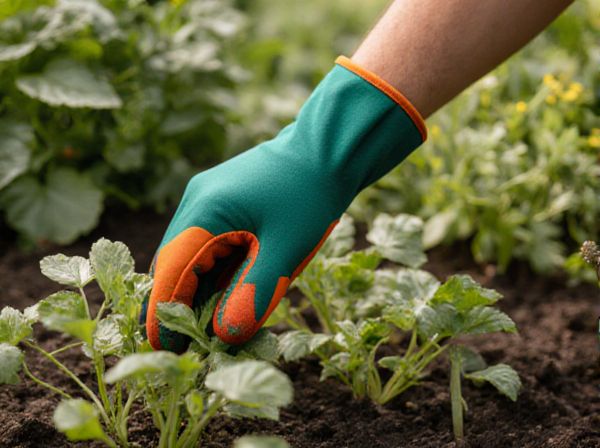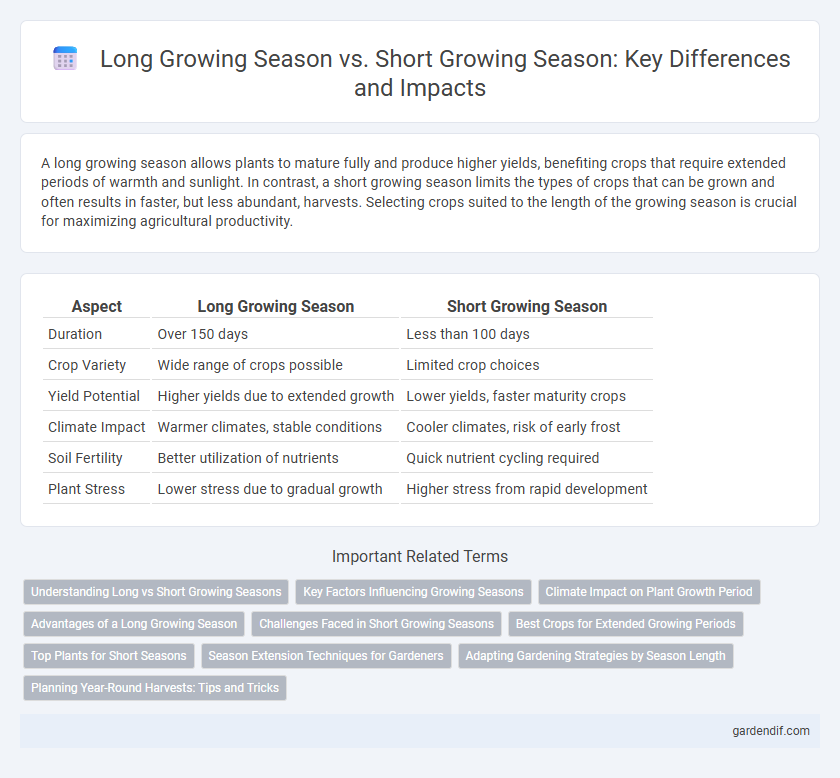
Long growing season vs Short growing season Illustration
A long growing season allows plants to mature fully and produce higher yields, benefiting crops that require extended periods of warmth and sunlight. In contrast, a short growing season limits the types of crops that can be grown and often results in faster, but less abundant, harvests. Selecting crops suited to the length of the growing season is crucial for maximizing agricultural productivity.
Table of Comparison
| Aspect | Long Growing Season | Short Growing Season |
|---|---|---|
| Duration | Over 150 days | Less than 100 days |
| Crop Variety | Wide range of crops possible | Limited crop choices |
| Yield Potential | Higher yields due to extended growth | Lower yields, faster maturity crops |
| Climate Impact | Warmer climates, stable conditions | Cooler climates, risk of early frost |
| Soil Fertility | Better utilization of nutrients | Quick nutrient cycling required |
| Plant Stress | Lower stress due to gradual growth | Higher stress from rapid development |
Understanding Long vs Short Growing Seasons
Long growing seasons, typically lasting more than 150 days, enable multiple crop cycles and increased agricultural yield due to extended warm temperatures and ample sunlight. Short growing seasons, often under 100 days, limit crop choices to fast-maturing varieties and require careful planning to maximize growth within limited frost-free periods. Understanding the length of the growing season is crucial for selecting suitable crops, optimizing planting schedules, and achieving sustainable farming outcomes.
Key Factors Influencing Growing Seasons
Temperature patterns, daylight duration, and soil moisture levels are key factors influencing the length of growing seasons. Regions with consistently warm temperatures and longer daylight hours typically experience extended growing seasons, allowing for multiple crop cycles. Conversely, shorter growing seasons are common in areas with cooler climates, limited sunlight, and restricted moisture availability, which constrain plant growth and development.
Climate Impact on Plant Growth Period
Long growing seasons, typically found in temperate and tropical climates, provide plants with extended periods of warmth and sunlight, enhancing photosynthesis and resulting in higher crop yields. Short growing seasons, common in polar and high-altitude regions, limit plant development due to cooler temperatures and reduced sunlight, often necessitating the use of cold-tolerant or fast-maturing crop varieties. Climate impacts, such as temperature fluctuations and changing frost dates, significantly influence the length and productivity of the growing season, affecting agricultural planning and food security.
Advantages of a Long Growing Season
A long growing season provides extended sunlight and warmer temperatures, promoting higher crop yields and better-quality produce. It allows for multiple planting cycles and diverse crop varieties, enhancing farm productivity and profitability. Consistent moisture availability during an extended season supports healthier plant development and reduces the risk of crop stress.
Challenges Faced in Short Growing Seasons
Short growing seasons present significant challenges, including limited time for crops to mature, resulting in reduced yields and increased vulnerability to unpredictable weather conditions such as early frosts. Farmers must select fast-maturing plant varieties and optimize planting schedules to maximize growth within the condensed timeframe. Soil fertility management and pest control become critical to ensure robust plant development despite the restricted season length.
Best Crops for Extended Growing Periods
Extended growing seasons favor heat-loving and slow-maturing crops such as tomatoes, peppers, eggplants, and melons, which thrive with prolonged warmth and sunlight. Root vegetables like carrots and beets, along with beans and cucumbers, also benefit from longer periods of growth, producing higher yields and better quality. Selecting crops adapted to long growing seasons maximizes harvest potential and optimizes farm productivity in regions with extended frost-free intervals.
Top Plants for Short Seasons
Short growing seasons favor cold-tolerant, fast-maturing plants like radishes, lettuce, and spinach, which can thrive and produce a harvest within 30 to 60 days. Crops such as kale, chard, and peas also perform well in brief summers, maximizing growth before frost. Selecting dwarf or bush varieties accelerates development, ensuring successful yields despite limited warm weather.
Season Extension Techniques for Gardeners
Gardeners employ season extension techniques such as row covers, cold frames, and high tunnels to maximize productivity during a long growing season and protect crops from early frosts in a short growing season. Using these methods, gardeners can extend the harvest period by several weeks or even months, allowing for sustained growth and increased yield. Proper temperature regulation, soil management, and selecting frost-resistant plant varieties further enhance the effectiveness of season extensions in diverse climates.
Adapting Gardening Strategies by Season Length
Gardening strategies must adapt to the length of the growing season to optimize plant health and yield; in long growing seasons, gardeners can cultivate a wider variety of crops and implement succession planting for continuous harvest. Short growing seasons require selecting fast-maturing, cold-tolerant plant varieties and utilizing techniques such as raised beds, row covers, and greenhouses to extend the effective growing period. Understanding local climate patterns and frost dates is essential for timing planting and maximizing seasonal productivity efficiently.
Planning Year-Round Harvests: Tips and Tricks
Long growing seasons enable farmers to plan year-round harvests by allowing multiple planting cycles and diverse crop rotations, maximizing yield and continuous produce supply. Short growing seasons require careful crop selection and staggered planting schedules to optimize limited frost-free days, ensuring consistent harvests despite time constraints. Employing season extension techniques such as greenhouses, row covers, and high tunnels can mitigate seasonal limitations and enhance planning efficiency.
Long growing season vs Short growing season Infographic

 gardendif.com
gardendif.com